|
1.
CENTRAL/ WEST AFRICA
Business slow in West Africa as European holidays continue
West African log trade remained very slow and selective,
although one encouraging sign was the steady business in
okoume logs for China. Even for this destination, prices
had eased by USD3 to 5/m³, but the level of trade was
much more satisfactory than only five or six weeks ago.
The bulk of the volume of old okoume log stocks sold to
China at reduced prices has now been shipped. This alone
has removed a significant deterrent to new business.
Regarding other log species, there were no changes in
prices through the past two to three weeks, but business
was very selective. There were still reports of relatively
high stocks in importing countries. Demand for okan has
improved slightly and dabema also has been of greater
interest recently. Prices had not changed and though the
market appears reasonably stable, the total level of trade
was not high. Should serious buying resume there is no
doubt importers will drive very hard bargains.
No price changes were reported for sawn lumber. Demand
was low and without signs of significant buyer interest.
The end of the European vacations might result in some
spot buying to fill gaps in stock although importers and
merchants were reporting very slow demand as building
activity in most European countries remained at a low
level. The UK industry seems to be suffering as a result of
the country¡¯s economic slow down. Major housebuilders
have closed down new build sites due to lack of buyers.
Economists are forecasting at best a slow recovery over
the next two years.
Sapele was possibly the worst affected species, with high
stocks of sold but unshipped supplies still waiting in the
ports for buyers to give shipment instructions. New
business was said to be only in small volumes for prompt
shipment to fill gaps in importers¡¯ stock or for specific
orders. Sapele prices were weak and very variable with
shippers keen to accept almost any serious offer to move
stock into consumption.
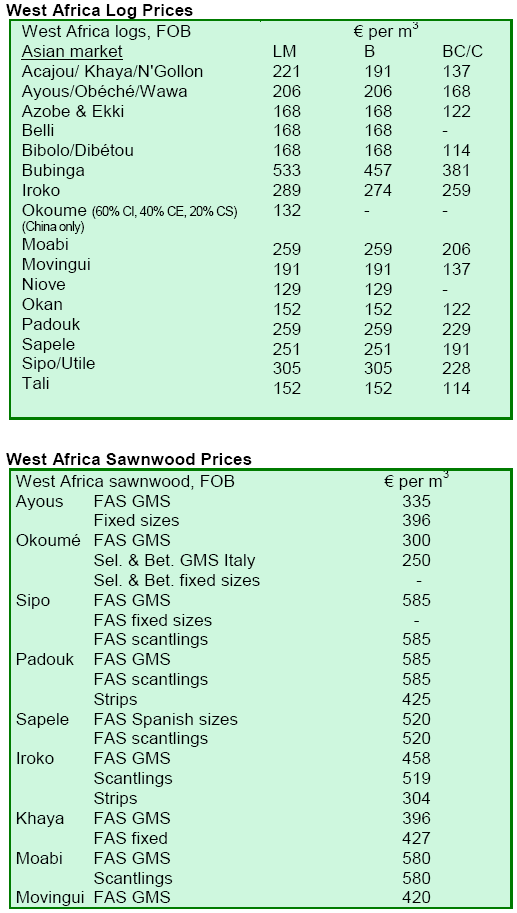
2. GHANA
Ghana posts gains in exports for the first half of 2008
Ghana exported 287,224 m³ of wood products for the
January to June 2008 period, earning EUR96.5 million.
This resulted in gains of 8.0% and 3.8% by volume and
value, respectively, compared to the same period of last
year. Kiln dried lumber (21.4%), air dried lumber (11.7%)
and plywood (25.7%) altogether accounted for 58.8% of
the total volume exported the first half of the year. Table 1
below shows the pattern of wood products exports for the
period under review compared to 2007:
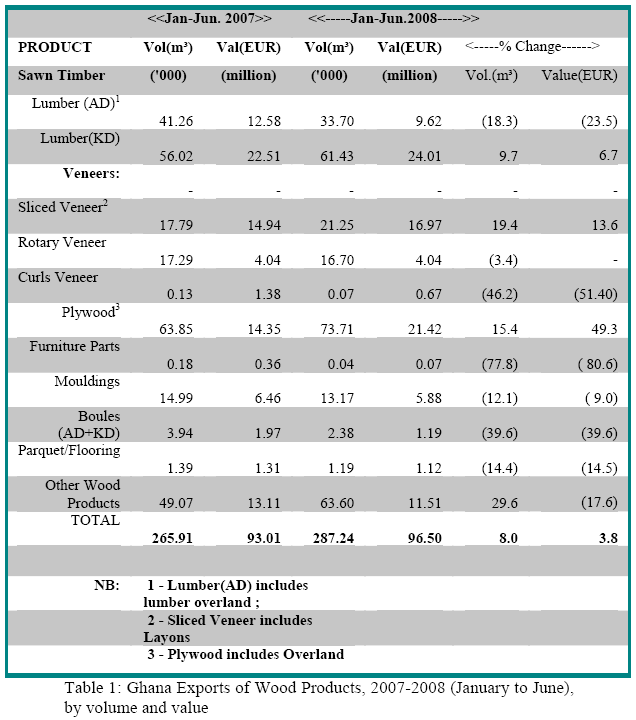
Kiln dried lumber exports increased from 56,020 m³ in
2007 to 61,430 m³ in 2008, a 9.7% year-on-year increase.
Revenue from lumber (KD) also grew from EUR 22.51
million in 2007 to EUR 24.01 million in 2008. Over the
same period, the total volume of air-dried lumber,
including overland exports registered a 18.3% drop in
volume compared to the previous year. The revenue from
lumber (AD) was EUR9.62 million, showing a 23.5%
decrease compared to year 2007.
Exports of sliced veneer, including lay-ons, increased to
21,250 m³ in 2008 from the previous year¡¯s record of
17,790 m³. The volume of rotary veneer exports for 2008
dipped 3.4% to 16,073 m³, although there was no
significant change in export revenue for the period
compared to 2007. The 2008 curl veneer export also
dropped by both volume and value, registering decreases
of 46.2% and 51.4%, respectively.
The volume of furniture parts decreased from 181 m³ to
2007 to 41 m³ 2008, with export revenue from the product
decreasing 80.6% to EUR0.7 million in 2008. Plywood
exports rose to 73,710 m³ from a volume of 63,850 m³ in
2007, a jump of 15.4%. The export revenue from plywood
exports for 2007 and 2008 were EUR14.35 million and
EUR21.42 million, respectively.
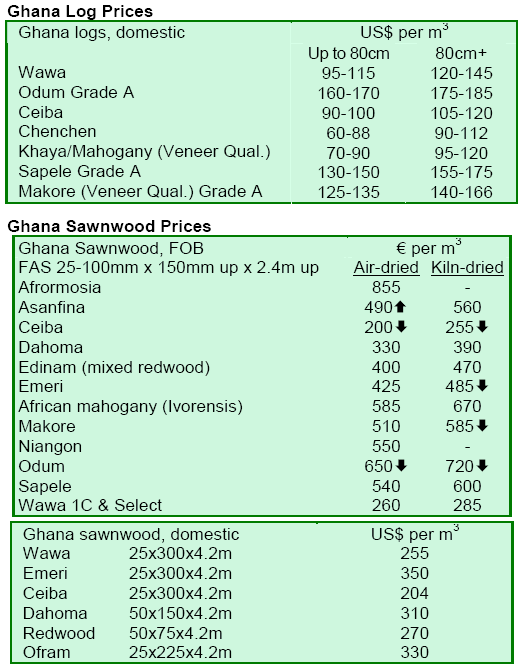
3.
MALAYSIA
Malaysia establishes GCC-Asean Economic Center
Malaysia has recently established the Gulf Cooperation
Council ¨C Asean Economic Center (GAEC) in Kuala
Lumpur, reported Bernama. The new center is expected to
facilitate trade and investment activities between the GCC
and Asean countries. Mr. Muhyiddin Yassin, Malaysia¡¯s
Minister of International Trade, hoped the center would
yield positive increases in trade and investment for both
the Asean and GCC areas and help Malaysia and Asean
countries expand operations in the Middle East.
Muhyiddin expected room for trade expansion and
opportunities for the GCC to invest in the manufacturing
and services sectors in Malaysia. He noted that Malaysia
could help launch GCC companies into the regional
market, which had a combined GDP of USD1.1 trillion.
As of June 2008, trade between the GCC and Malaysia
was around USD9.5 billion and the GCC¡¯s investment in
Malaysia was about USD3.6 billion.
Malaysia announces dates for 15th International Furniture Fair
According to Furniture Today, Malaysia has announced
that the 15th Malaysian International Furniture Fair (MIFF
2009) will be held on 3¡ª7 March 2009 at the Putra World
Trade Center and the MATRADE Exhibition and
Convention Center. Last year¡¯s MIFF drew over 19,500
visitors and generated USD690 million in sales. MIFF
organizers are hoping to keep the show focused on style,
innovation and quality to cater to the needs of the
international market.
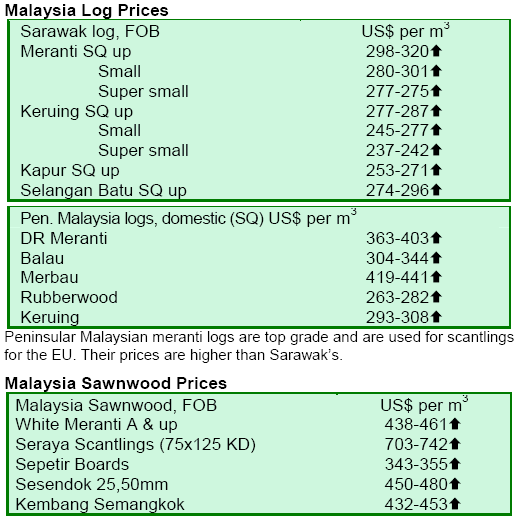

4.
INDONESIA
Trade mission raises hopes for greater investment in
Indonesia
During a three-day visit to Beijing this August, Indonesian
Trade Minister Mari Elka Pangestu met with Chen
Deming, the Chinese Trade Minister, to facilitate trade and
investment issues between the two countries, said Antara
News. Due to increasing cooperation of Chinese
companies with their Indonesian counterparts, Indonesia
believes furniture makers will import both Indonesian logs
and produce furniture. This is hoped to improve valueadding
and attract greater foreign investment.
Australian Minister¡¯s visit focuses on illegal logging
ABC Radio Australia reported on a recent meeting
between Australia¡¯s Forestry and Fisheries Minister Tony
Burke and his Indonesian counterpart, which highlighted
illegal logging as a priority item. Mr. Burke noted that
Australia had been working with Indonesia to halt illegal
logging and promote sustainable forest management
(SFM). To illustrate this point, he explained how Australia
was working with a community in Kalimantan, Borneo, to
show how income could be generated from SFM and
benefits distributed to the wider community.
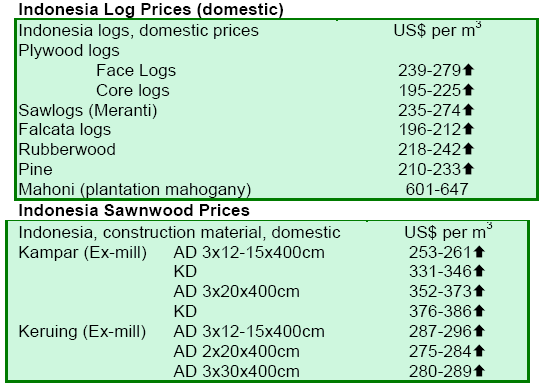
5.
MYANMAR
Teak market unchanged since May 2008
The teak market in Myanmar seems to have held steady
since May 2008. There has been some uncertainty in the
market as new list prices could soon be issued. A regular
list price has been hoped for by buyers and sellers, as they
have had problems working with the average prices, which
change on a monthly basis. Some buyers are reported to be
waiting to see the developments on the new price list
before making purchases.
Bago Yoma Greening Plan sets 2008-2009 targets
The Bago Yoma (the central mountain range) is located in
the south central Myanmar region and traverses from
Yangon in the south to the north in central Myanmar. The
range is about 270 miles long and where teak and
pyinkado logs are found in abundance.
As part of the Bago Yoma Greening Plan for 2008-2009,
427,610 acres of remaining natural forests will be
protected and rehabilitated, 47,000 acres of enrichment
planting will take place, and 58,750 acres will undergo
artificial regeneration. The following areas will also be
established as plantation areas: 19,400 acres for teak
plantations; 1,650 acres of commercial hardwood
(pyinkado) plantations; 17,890 acres around watershed
areas; 7,000 acres for village firewood supply; 2,000 acres
for industrial raw materials; and 490 acres for other
purposes.
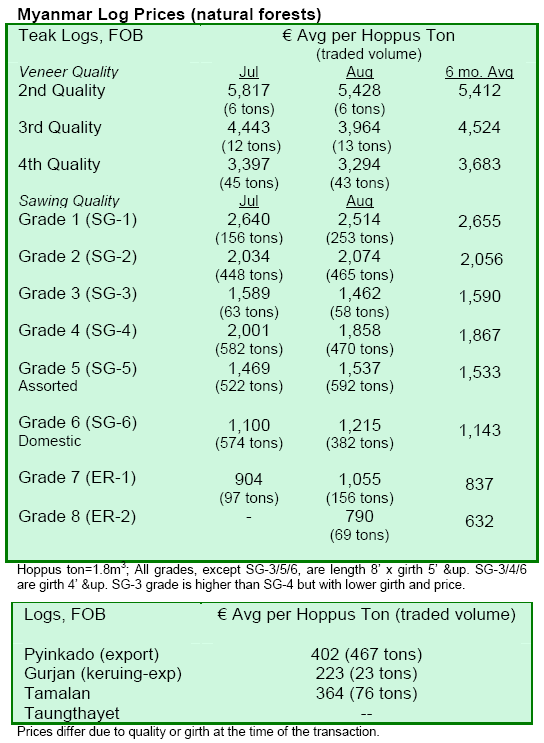
6.
BRAZIL
Prices rise as a result of currency appreciation
While wood product prices have not changed in Brazilian
Real, prices in US dollars rose on average 3.7% due to the
Brazilian currency¡¯s appreciation against the US dollar.
The government Consumer Price Index for the June 2007-
2008 period was 6.37% in comparison to 6.06% from the
June 2006-2007 period. However, this was still within the
upper limit of the government¡¯s inflation target for 2008 of
6.5%. The prime interest rate continued to be at 13%, and
the next meeting of the Monetary Policy Committee at end
August would discuss whether to keep this rate, which
aims to control inflation without significantly impacting
economic growth.
Weak US housing market reduces consumption of Brazilian wood products
O Estadão reported on the UN Food and Agriculture
Organization (FAO) and UN Economic Commission for
Europe¡¯s (UNECE) recent survey, which discussed how
the fall in construction in the US and some parts of Europe
had been reducing wood exports from Brazil and other
Latin American countries. With nearly 70% of wood
imports and production going to the construction sector,
the market for wood and paper had dropped in developed
countries for the first time in nearly six years. Latin
American furniture exporters had been particularly hard
hit over the last two years, as nearly 50% of the entire
supply of high value-added wood from Latin America was
directed to the US market. For Brazil, the Chinese market
and domestic demand had enabled tropical wood
production to grow.
Brazil to host PROMADEIRA event
In late August 2008, Brazil¡¯s largest event for the forestbased
sector, PROMADEIRA, was held. Wood, furniture
and machinery and equipment were the three major
exhibitions at the PROMADEIRA event. It also hosted
national and international business meetings and
conferences with well-known global experts and
workshops for the furniture and forestry sectors.
PROMADEIRA is a bi-annual event held in the
Amazonian state of Mato Grosso.
PROMADEIRA 2008¡¯s theme was focused on forest
management practices, with a particular focus on
promoting sustainability through management techniques.
The event was expected to raise awareness of forest
conservation and sustainable use of natural resources. The
event organizers were the Center for Industrial Wood
Producers and Exporters of Mato Grosso State (CIPEM),
the Federation of Mato Grosso State Industries (FIEMT)
and the Timber Industry Association of Northern Mato
Grosso State (SINDUSMAD).
Exports for wood products fall 7.3% in July
General wood products exports (except pulp and paper)
fell from USD331 million in July 2007 to USD307 million
in July 2008, a 7% decrease. Exports of pine sawnwood
fell the most, by almost 28%, with exports down from
USD19.5 million in July 2007 to USD14.1 million in July
2008. The charts below show the volume and value of
exports for July 2008 compared to the same month a year
earlier:
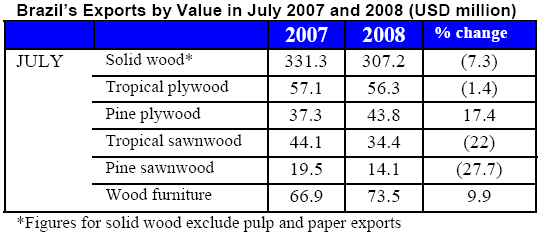

US furniture imports from Brazil lose competitive edge
The Jornal do Com¨¦rico reported that the Brazilian
furniture industry had lost its competitiveness in recent
years due to the weakening US dollar. Brazilian
companies were aiming to use their comparative
advantages in the market to reverse the negative trends,
but this seemed not to have occurred. The total value of
exports to the US from January¡ªJune 2008 was USD9.5
million compared to USD15.7 million during the same
period in 2007. Currently, Brazil lags behind the UK,
Argentina, and Chile in its exports to the US.
According to the Center for Management and Innovation
(CGI), the US accounts for 51% of world sales in the
furniture sector. It is hoped that the US market can be
expanded or recovered by Brazil by using new strategies,
innovative product design and more focused marketing
techniques. CGI expects to develop new strategies for
transport logistics and to tap into new export destinations.
Others have recognized the need to break into or expand
non-US markets. APEX Brasil (the Brazilian Agency for
Export Promotion and Investments) intends to create
business centers in Lisbon, Warsaw and Frankfurt so that
companies can negotiate contracts with potential clients
and use them as references for establishing subsidiaries.
China and African countries are also considered as
potential buyers, according to APEX.
In order to promote Brazilian products, APEX Brasil will
convene a ¡®Brazil Design House¡¯ fair in Buenos Aires in
the first week of September 2008. Argentina has been
selected to host the event as it is the second largest
importer of Brazilian products, with Brazilian exports to
Argentina totaling USD53.6 million in the first half of
2008, a 50% increase compared to the same period of
2007.
South American countries expand interest in Brazilian furniture
According to the Brazilian Ministry of Development,
Industry and Foreign Trade (MDIC), Brazilian furniture
exports to Peru increased 130% by value in the first half of
2008, said Portal Moveleiro. Paraguay, Venezuela and
Argentina also showed positive gains in imports of 77%,
53% and 50%, respectively, during the same period. In the
South American region, only Ecuador decreased its
imports of Brazilian furniture by 14% over the period.
Several factors contributed to this significant increase of
exports to neighboring countries, including highly
proactive business leaders promoting Brazilian products in
neighboring countries and lower transportation costs due
to the proximity to South American importers. According
to importers, Brazilian products had a competitive edge,
given their quality and prices when compared to Chinese
products, Brazil¡¯s main competition.
Total furniture exports of Brazil decreased marginally
(0.27% by value) in the first half of 2008. Brazilian
furniture exports totaled USD471.0 million during the first
half of 2008, compared to USD472.3 million during the
same period in 2007. According to Brazilian Association
of Furniture Industries (ABIMOVEL) estimates, Brazilian
furniture exports are expected to grow 5% by the end of
2008.
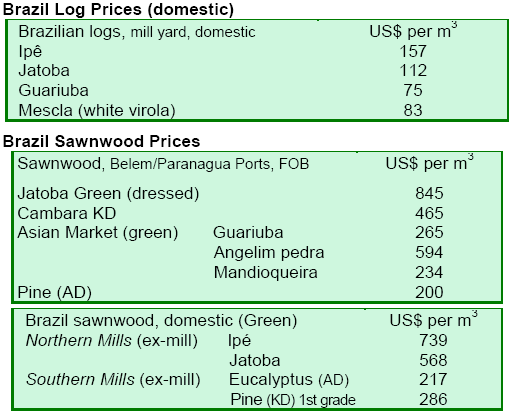
7.
PERU
Wood exports grow 15% in first half of 2008
According to the Peruvian Export Association (ADEX),
wood exports from January through June 2008 grew 15%,
with exports rising USD119.07 million from USD103.38
million during the same period in 2007. Even as wood
exports from January to June 2008 had grown, this was not
an expected trend.
Exports in the month of June 2008 were USD6.71 million
less than exports during June 2007. The volume of wood
products exported to the US and Mexico eased in June
2008, in contrast to an increase in exports to China during
the same period. Part of the fall in the month of June 2008
was caused by strong currents in the Amazon River, which
made navigation dangerous.
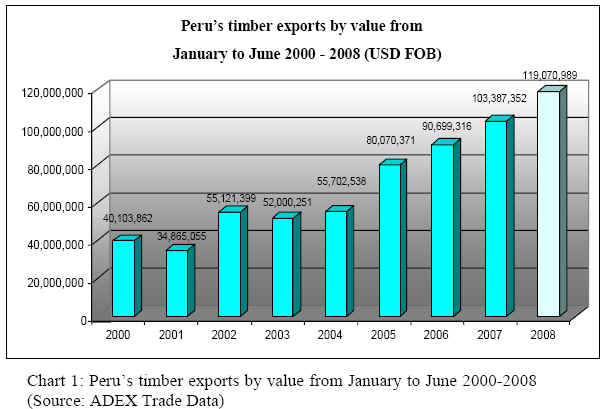
Sawnwood was the most exported item, representing about
47% of exports in the sector. Sawnwood exports between
January-June 2008 were USD55.86 million, a rise of about
4% from first half 2007 exports by value. However,
sawnwood exports dropped USD7.66 million in June 2008
compared to the same month in 2007. The main markets
for Peru¡¯s lumber are Mexico (51%), the US (26%) and
China (11%).
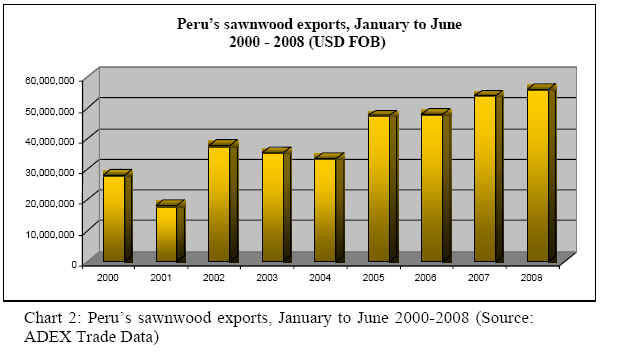
Peru¡¯s semi-manufactured products represented almost
29% of wood sector exports from January to June 2008
and were valued at USD34.20 million. This represented a
27% gain from 2007, when exports were valued at
USD26.87 million. Exports of semi-manufactured
products for the month of June 2008 showed a
USD405,530 increase from June 2007. This was a result of
the growth in decking exports for which China was the
main destination market, representing 70% of sub-sector
exports.
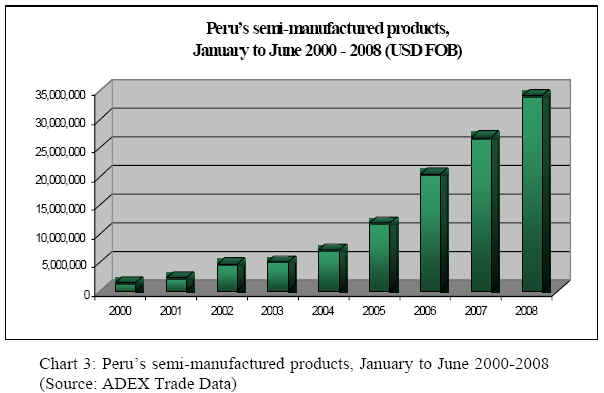
Veneer and plywood exports were USD15.45 million
during the January to June 2008 period, up from
USD10.88 million from the same period in 2007. Exports
of veneer and plywood in June 2008 alone showed a yearon-
year gain of USD1.06 million. Exports show Mexico as
the main market (89%), followed by Venezuela (8%).
Furniture exports were valued at USD6.92 million for the
January to June 2008 period, a drop of 18%. Results for
the same period in 2007 were valued at USD8.49 million.
June 2008 exports were USD914,000 less compared to the
same month of 2008.
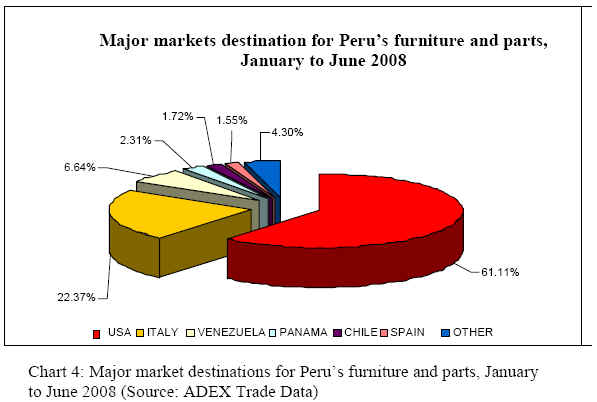
The US was the main market for furniture exports, as it
received 61% of exports. The share of the US¡¯s furniture
exports had diminished as a result of the US economic
slowdown. During the January to June 2008 period,
exports were concentrated in three markets which received
84% of total wood sector exports: Mexico (38%), China
(25%), and the US (22%).
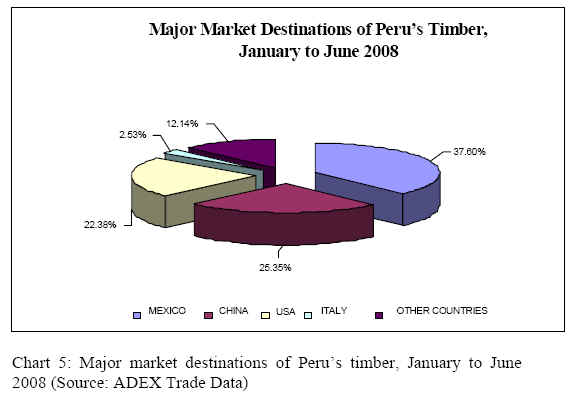
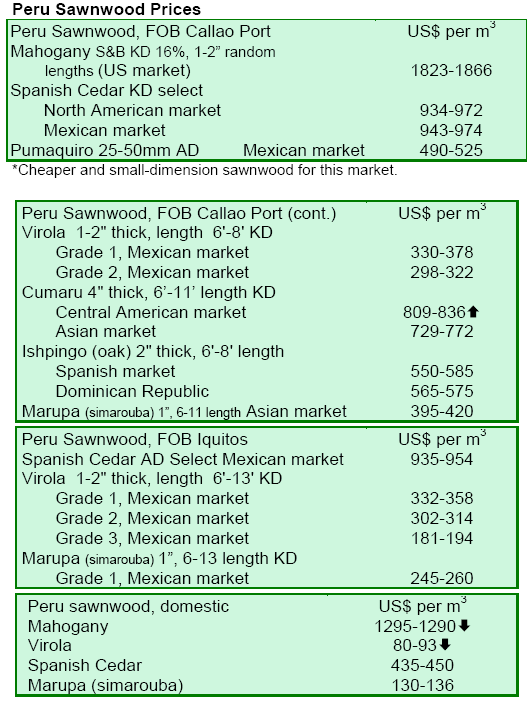
8. BOLIVIA
Bolivian exports slide 12% from January to April 2008
During the period January to April 2008, exports of
Bolivian forestry products registered a fall of 12% by
value in comparison to the same period of 2007. This
broke a positive trend that has lasted since 2002, as the
total value of products dropped from USD59.71 million to
USD52.59 million. The main causes of the downward
trend were the shortage of diesel supply, depreciation of
the US dollar, and the downturn of the housing market in
the US and parts of Europe.
Although the decrease in exports originated from the
manufactured products sector, 76.97% of the sector¡¯s
exports were forest products during the first four months
of 2008. Of total exports, USD40.48 million comprised
mainly of products such as chestnut without husks, doors,
canned palm tree hearts, plates, parquet, chairs, decking,
and fiberboards. Another USD12.11 million (23%)
consisted of semi-manufactured products which include
sawn wood, small wood planks and posts.
Exports of wood products were USD30 million in value,
or 57% of the total, and non-wood forest product export
accounted for USD22.55 million by value. In comparison
to 2007, twelve fewer products were exported in 2008. Of
total exports, USD11.93 million of sawnwood was
exported, followed by doors (USD3.82 million), plates
(USD2.51 million), parquet (USD2.38 million), chairs
(USD1.32), decking (USD1.18 million) and fiberboard
(USD1.10 million). By volume, the main species exported
were oak, followed by almond tree, pink lapacho,
chinchona and curupay, among 50 other species.
The US is the most important market for Bolivia¡¯s wood
product exports (USD17.94 million), followed by the UK
(USD6.59 million) and Argentina (USD3.46 million). Just
as in 2007, a total of 49 countries purchased Bolivian
forestry products.

9. MEXICO
ProTree expands work for communities
In 2008, the National Forestry Agency CONAFOR will be
using USD130 million to fortify common rural and forest
communities located mainly in indigenous zones and
highly remote areas. The programme will help common
rural forest communities strengthen timber forest
resources management, identify alternatives to take
advantage of non-timber resources and establish areas for
conservation, recovery and restoration of degraded areas.
Mexico extends Procymaf programme
The Programme of Communitarian Forest Development
(Procymaf) was founded in 1997 in Oaxaca and extended
in the states of Guerrero and Michoacan. After 2004, a
second phase of the programme, Procymaf II, began and
was extended to the states of Durango, Jalisco and
Quintana Roo. Due to the results of Procymaf II, the
programme will be extended for a third phase in the states
of Campeche, Chiapas, Chihuahua, Puebla and Veracruz
in 2008. The overall programme will be reviewed in 2009.
Mexico¡¯s efforts to stop deforestation receive further World Bank funding
Fourteen countries, including Mexico, Bolivia, Costa Rica
and Panama will be receiving the first resources from the
Forest Carbon Partnership Facility (FCPF) to stimulate
efforts to combat climate change. The Fund, created by the
World Bank in 2007 and operationalized last June, is
expected to receive financial support from governments,
private companies and the general public. Funds will be
allocated via agreements with developing countries to
reduce greenhouse gases. Currently, the Fund covers the
Congo, Gabon, Ghana, Kenya, Liberia, Madagascar,
Bolivia, Costa Rica, Guyana, Panama, Nepal, Laos and
Vietnam.
10.
GUYANA
Sawn lumber exports continue to pick up in 2008
Exports of dressed sawn lumber continued to rise during
the first half of 2008, jumping 40% in 2008 compared to
the same period in 2007, accounting for 15% of total
sawnwood exports. This offered encouraging news to local
manufacturers who in the past have pointed to challenges
in gaining raw materials to meet their capacity.
This outcome had increasingly been anticipated over the
past few months as Guyana experienced a shift from
exports of undressed lumber to dressed lumber as further
processed lumber obtained higher value in the markets.
Barbados, Guyana¡¯s most lucrative and leading destination
for this dressed lumber, recently shifted its demand from
undressed to dressed lumber, which has helped boost
exports in the first half of 2008.
A comparative analysis also revealed a 17% increase in
average prices for dressed lumber over 2007 figures.
Despite this shift, undressed lumber continued to account
for a fairly large share of total exports, mainly because of
higher and continued demand from other markets
including many in the Latin American/Caribbean region.
The leading destinations for undressed sawn lumber were
China, the Netherlands and US. Overall, sawnwood
exports had increased both in volume and value.
New project will address value adding for SMEs
Guyana was successful in securing funding to implement
an ITTO project ¡®Value-adding and Kiln Drying of
Commercial Timbers by Small Scale Community Saw
Millers in Guyana¡¯.
The objective of the project is to use kiln drying
techniques to increase value-adding within small scale
community saw mills in Guyana. The results of the project
should demonstrate the necessity and value of drying
wood to meet market specifications, the need to invest in
kiln drying technology and the importance of enhancing
competitiveness through marketing products based on
value rather than price alone.
The project aims to establish three kilns at strategic
locations in Guyana for use by small operators in an effort
to expand the use of this technology in forest products
manufacturing. This project will also conduct trail runs of
commercial kiln drying of wood in three small scale
community sawmilling regions to demonstrate valueadding
processes and quality standards expected by
international markets. It is expected that through these
demonstration projects, the small scale community saw
millers will understand and learn the requirements for
exporting to international markets.
This project comes at a strategic time when the Guyana
Forestry Commission (GFC) has been enforcing standards
to improve quality in specific processing facilities in
Guyana. The project will see direct involvement of the
private sector, particularly small operators and forest
products manufacturers in Guyana. A series of national
consultations is being planned for September 2008 where
the inputs of stakeholders in the three counties of Guyana
will be sought and incorporated into the project planning
activities. This project will be coordinated by the GFC.
Lesser Used Species project shows encouraging results
Guyana¡¯s ITTO Project on ¡®Enhancing the Utilization of
Lesser Used Wood Species¡¯, is showing positive results in
enhancing production levels of many of the species
targeted under the initiative. The project activities include
a combination of lab tests done on technical properties of
15 lesser used species, as well as a series of marketing and
promotion initiatives all aimed at boosting the utilization
and demand of these key species.
The Guyana Forestry Commission has announced an
increase in production for lesser used species, which is
leading to an expansion of the species utilization base in
Guyana¡¯s forest product sector. Recent trends have shown
that several of the 15 species that were selected for
promotion are now being harvested on a more commercial
and sustainable basis. These species were found in a fair
level of abundance in Guyana¡¯s forests but were not being
utilized.
From January to July 2008, muniridan and iteballi, two of
the lesser used species under the ITTO project, ranked as
the tenth and eleventh highest species harvested
nationally, with darina and dalli also included in the top 20
species harvested in 2008. Production for ten of the 15
lesser used species (dalli, fukadi, futui, iteballi,
itikiboroballi, kurokai, muniridan, suya, wadara and
morabukea) had increased as much as 16% ¨C 35% from
2006 to 2007 levels.
Exports of these species had also increased, especially to
the Asian markets such as China and India, and to some
extent the UK. Some exports of these species are to closer
locations, including to countries such as Venezuela and St.
Vincent. In 2007, iteballi and muniridan exports to these
destinations grew significantly by volume.
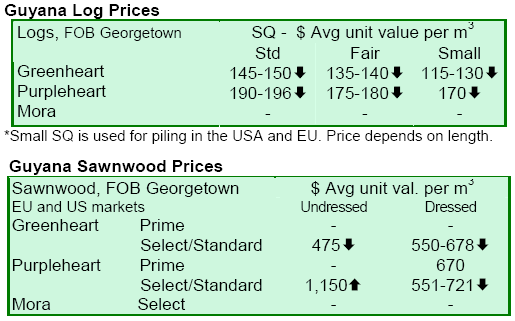
|